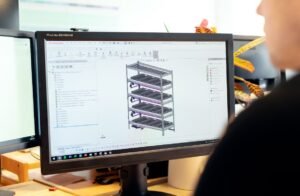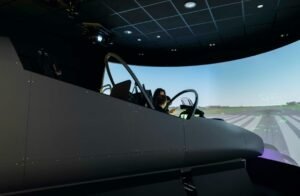Generative Art and AI
Generative art refers to the creation of artwork using autonomous systems, such as artificial intelligence (AI) algorithms or computer programs. By employing AI, generative artists can explore new creative possibilities and produce art that is dynamic, interactive, and constantly evolving.
Key Takeaways:
- Generative art: Art created using autonomous systems, like AI algorithms or computer programs.
- AI in generative art: AI enables artists to explore new creative possibilities and produce dynamic, interactive, and constantly evolving artwork.
- Inspiring creativity: Generative art can inspire creativity by offering unique perspectives and challenging traditional artistic processes.
Generative art leverages AI to generate unique visual and auditory experiences that are not pre-determined or manually created. *It combines the artist’s creative input and the AI’s algorithms to produce artwork that continues to evolve over time.* This emerging field pushes the boundaries of traditional art forms and challenges our perception of what it means to create something truly original.
The Intersection of Art and AI
Generative art represents the intersection of art and AI, utilizing AI algorithms to generate complex artistic forms. *It enables artists to tap into the immense computational power of AI to create dynamically changing art pieces that respond to external stimuli or evolve based on predefined rules.* The fusion of human creativity and AI computation paves the way for endless possibilities in artistic expression.
Applications of Generative Art and AI
Generative art powered by AI has found applications in various fields, including:
- Architecture: AI algorithms shape and refine architectural designs, generating innovative structures.
- Fashion: AI-generated patterns and designs inspire fashion designers and influence clothing aesthetics.
- Music: AI algorithms compose original music pieces that challenge traditional composition techniques.
Benefits and Challenges
Generative art fueled by AI presents both benefits and challenges:
- Benefits:
- Unlimited creativity: AI algorithms can generate vast amounts of unique possibilities, pushing artistic boundaries.
- Efficiency: AI-powered tools automate certain creative processes, reducing manual labor and time consumption.
- Exploration of randomness: Generative art allows artists to embrace randomness and explore unexpected outcomes.
- Challenges:
- Loss of human touch: Some argue that generative art lacks the human element and emotional connection present in traditional art.
- Ethical considerations: The use of AI raises ethical questions, such as ownership of AI-generated artwork or potential biases in algorithms.
- Technical complexity: Artists need to develop a deep understanding of AI and its implementation to create generative artwork effectively.
Generative Art and AI in Numbers
| Statistic | Value |
|---|---|
| Percentage of artists using AI in their creative process | 34% |
| Number of generative art exhibitions worldwide in 2020 | 123 |
| Investment in AI art startups in the last year | $420 million |
The Future of Generative Art
Generative art driven by AI is an evolving field that nurtures creativity and expands artistic expression. *As AI continues to advance, generative art is expected to become more sophisticated and prevalent, pushing the boundaries of traditional artistic practices.* Whether it’s exploring new mediums, creating interactive installations, or finding novel ways to engage audiences, the future of generative art is boundless.
Generative Art and AI – A Creative Frontier
Generative art, enabled by AI, offers a new dimension to the world of creativity. By leveraging the power of algorithms and technology, artists can create dynamic and ever-evolving artwork that challenges conventional art forms. *With its increasing popularity and unprecedented possibilities, generative art powered by AI is truly a creative frontier waiting to be explored.*
Generative Art and AI
Generative art refers to the creation of artwork using autonomous systems, such as artificial intelligence (AI) algorithms or computer programs. By employing AI, generative artists can explore new creative possibilities and produce art that is dynamic, interactive, and constantly evolving.
Key Takeaways:
- Generative art: Art created using autonomous systems, like AI algorithms or computer programs.
- AI in generative art: AI enables artists to explore new creative possibilities and produce dynamic, interactive, and constantly evolving artwork.
- Inspiring creativity: Generative art can inspire creativity by offering unique perspectives and challenging traditional artistic processes.
Generative art leverages AI to generate unique visual and auditory experiences that are not pre-determined or manually created. *It combines the artist’s creative input and the AI’s algorithms to produce artwork that continues to evolve over time.* This emerging field pushes the boundaries of traditional art forms and challenges our perception of what it means to create something truly original.
The Intersection of Art and AI
Generative art represents the intersection of art and AI, utilizing AI algorithms to generate complex artistic forms. *It enables artists to tap into the immense computational power of AI to create dynamically changing art pieces that respond to external stimuli or evolve based on predefined rules.* The fusion of human creativity and AI computation paves the way for endless possibilities in artistic expression.
Applications of Generative Art and AI
Generative art powered by AI has found applications in various fields, including:
- Architecture: AI algorithms shape and refine architectural designs, generating innovative structures.
- Fashion: AI-generated patterns and designs inspire fashion designers and influence clothing aesthetics.
- Music: AI algorithms compose original music pieces that challenge traditional composition techniques.
Benefits and Challenges
Generative art fueled by AI presents both benefits and challenges:
- Benefits:
- Unlimited creativity: AI algorithms can generate vast amounts of unique possibilities, pushing artistic boundaries.
- Efficiency: AI-powered tools automate certain creative processes, reducing manual labor and time consumption.
- Exploration of randomness: Generative art allows artists to embrace randomness and explore unexpected outcomes.
- Challenges:
- Loss of human touch: Some argue that generative art lacks the human element and emotional connection present in traditional art.
- Ethical considerations: The use of AI raises ethical questions, such as ownership of AI-generated artwork or potential biases in algorithms.
- Technical complexity: Artists need to develop a deep understanding of AI and its implementation to create generative artwork effectively.
Generative Art and AI in Numbers
| Statistic | Value |
|---|---|
| Percentage of artists using AI in their creative process | 34% |
| Number of generative art exhibitions worldwide in 2020 | 123 |
| Investment in AI art startups in the last year | $420 million |
The Future of Generative Art
Generative art driven by AI is an evolving field that nurtures creativity and expands artistic expression. *As AI continues to advance, generative art is expected to become more sophisticated and prevalent, pushing the boundaries of traditional artistic practices.* Whether it’s exploring new mediums, creating interactive installations, or finding novel ways to engage audiences, the future of generative art is boundless.
Generative Art and AI – A Creative Frontier
Generative art, enabled by AI, offers a new dimension to the world of creativity. By leveraging the power of algorithms and technology, artists can create dynamic and ever-evolving artwork that challenges conventional art forms. *With its increasing popularity and unprecedented possibilities, generative art powered by AI is truly a creative frontier waiting to be explored.*

Common Misconceptions
Generative Art
Generative art is often misunderstood due to several common misconceptions. Let’s explore some of them:
- Generative art is just random or chaotic creations
- Generative art lacks human intention or creativity
- Generative art is always computer-generated and lacks physicality
AI in Generative Art
The involvement of Artificial Intelligence (AI) in generative art can also lead to misconceptions:
- AI-driven generative art removes the role of the artist entirely
- AI-generated art lacks emotional depth or human connection
- AI in generative art is inherently unethical or dangerous
Collaboration Between Artist and AI
A crucial aspect of generative art is the collaboration between artists and AI. However, people often misunderstand this relationship:
- The artist becomes a passive observer in the creative process when using AI
- AI takes complete control and the artist’s input is negligible
- Artists who use AI in generative art are not truly skilled or talented
Limitations of AI in Generative Art
Another misconception is related to the limitations of AI when used in generative art:
- AI can perfectly replicate any artistic style or technique
- AI’s creative output is always superior to that of human artists
- AI can generate art without any reference to existing artistic traditions

The Rise of Generative Art
Generative art is an innovative field that utilizes algorithms and artificial intelligence (AI) to create unique and dynamic artworks. This form of artistic expression has gained significant attention in recent years due to its ability to produce aesthetically pleasing and thought-provoking pieces. The following tables showcase different aspects of generative art and highlight the fascinating ways in which AI contributes to its creation.
Table: Evolution of Generative Art
This table illustrates the progression of generative art over time, showcasing significant milestones in its development.
| Year | Milestone |
|——|————————————————|
| 1956 | First experiments with computer-generated art |
| 1982 | Establishment of the Algorists art movement |
| 1995 | Emergence of fractal-based generative art |
| 2002 | Introduction of genetic algorithms in art |
| 2010 | Advancements in AI lead to neural art networks |
| 2016 | Development of style transfer techniques |
| 2020 | Generative adversarial networks redefine the art|
Table: Applications of Generative Art
This table explores various applications of generative art across different industries, demonstrating its versatility.
| Industry | Application |
|——————-|———————————————-|
| Advertising | Dynamic and personalized visuals |
| Fashion | Customizable textile patterns |
| Architecture | Innovative building designs |
| Film and Gaming | Procedural generation of landscapes and objects|
| Music | Algorithmic composition and generative sound |
| Education | Interactive learning through visualizations |
Table: Benefits of AI in Generative Art
This table identifies the advantages of AI in the creation of generative art, highlighting the unique contributions it brings to the artistic process.
| Benefit |
|—————————|
| Endless creative possibilities |
| Enhanced efficiency and productivity |
| Intelligent pattern recognition |
| Dynamic and adaptive compositions |
| Exploration of new aesthetics |
| Exploration of artistic styles |
Table: Influential Artists in Generative Art
This table showcases renowned artists who have made significant contributions to the field of generative art.
| Artist | Notable Works |
|——————-|——————————————————–|
| Frieder Nake | “Sine Curve Man,” “Matrix Multiplication,” “Lissajous Figures”|
| Vera Molnar | “Triangles Recursive,” “Matrix Logic,” “Mosaics” |
| Manfred Mohr | “Klangfelder,” “Cube Compositions,” “Cube Lines” |
| Casey Reas | “Processing,” “Synthetic Times,” “Messy Fragments” |
| Hiroshi Ishii | “Tangible Media Group,” “TransWall,” “Lumiscape” |
Table: Tools and Software for Generative Art
This table provides an overview of popular tools and software used by artists to create generative art.
| Tool/Software | Description |
|——————-|————————————————|
| Processing | Open-source programming language and environment|
| Max/MSP | Modular visual programming environment |
| vvvv | Multifunctional toolkit for real-time generative|
| Unity | Game development platform with generative art |
| Houdini | 3D animation software with procedural generation|
Table: Impact of Generative Art on the Art Market
This table examines the influence of generative art on the art market, exploring its market value and potential growth.
| Aspect | Impact |
|————————–|———————————————-|
| Market Value | Rising auction prices for generative artworks |
| Limited Editions | Creation of limited edition generative pieces |
| Cryptocurrency | Integration of generative art in NFT market |
| Art Collectors | Embracing generative artists and their works |
| Art Galleries | Exhibiting and selling generative art |
| Mainstream Recognition | Inclusion of generative art in prestigious museums |
Table: Ethical Considerations in Generative Art
This table addresses ethical concerns surrounding generative art, emphasizing the importance of responsible AI use.
| Ethical Considerations |
|—————————————————|
| Ownership and attribution of generative artworks |
| AI bias and underrepresentation in art creation |
| Exploitative use of AI-generated artworks |
| Transparency in AI algorithms used in art creation |
| Preservation and long-term accessibility |
| Cultural appropriation in generative art |
Table: Challenges in Generative Art Development
This table identifies the key challenges faced by artists and developers involved in generative art.
| Challenge |
|————————-|
| Balancing control and randomness |
| Overcoming AI limitations |
| Striking a balance between art and technology |
| Technical complexity of algorithms |
| Experimenting without compromising quality |
| Ethical decision-making in creative autonomy |
Table: Future Directions in Generative Art
This table explores potential future developments and trends in generative art, offering a glimpse into what the future holds.
| Direction |
|———————————–|
| AI-assisted collaborative art |
| Integration of generative AI in VR |
| Interactive generative installations |
| Integration of machine learning |
| Integration of robotics and art |
| Expanding cross-disciplinary collaborations |
Generative art, empowered by AI, has revolutionized the art world by pushing the boundaries of creativity and artistic expression. From its evolution to its applications and impact on the art market, these tables have captured the essence of generative art. As technology continues to advance, the future of generative art promises to be a dynamic and vibrant space that merges human creativity with artificial intelligence.
Frequently Asked Questions
What is generative art?
Generative art refers to artworks that are created through an autonomous or computational process, often utilizing algorithms or AI. These processes generate unique and unpredictable outcomes, resulting in visually captivating and innovative creations.
How does AI impact generative art?
AI plays a significant role in generative art by enabling artists to create intricate works that would otherwise be challenging or time-consuming. AI algorithms can generate random patterns, explore vast possibilities, and incorporate machine learning to refine and optimize artistic expressions.
What are some common techniques used in generative art?
Some common techniques used in generative art include fractal patterns, cellular automaton, genetic algorithms, swarm intelligence, neural networks, and data-driven art. These techniques allow artists to generate complex, dynamic, and interactive visual compositions.
Can AI create art independently without human input?
While AI can generate art autonomously, it still requires human input to varying degrees. Artists often provide initial parameters, creative direction, or curate the generated results. However, AI is constantly evolving, and future advancements may lead to more independent AI-generated art.
What are the benefits of using AI in generative art?
Using AI in generative art offers several benefits, including enhanced creativity and exploration of new artistic possibilities, increased efficiency and scalability in creating complex artworks, and the ability to discover unique patterns and compositions that may not have been conceived by human artists.
Is generative art considered a form of artificial intelligence?
Generative art is often categorized as a subset or application of artificial intelligence due to its reliance on algorithms and computational processes. However, it is important to note that not all generative art incorporates AI techniques, and generative art can exist independently of AI.
What tools or software are commonly used for creating generative art with AI?
Various tools and software are popular among generative artists utilizing AI, such as Processing, OpenFrameworks, Max/MSP, Python with libraries like TensorFlow or PyTorch, and dedicated generative art platforms like RunwayML or DeepArt.io.
Can generative art created by AI be considered original or authentic?
Generative art created by AI can certainly be considered original and authentic. Although the algorithm or system may be designed by humans, the final work is often unique, unpredictable, and distinct from any previous art piece. Each generated output can be considered an original creation.
Are there any ethical considerations in generative art with AI?
Like any application of AI, there are ethical considerations in generative art. Some concerns include issues of authorship and copyright, creative ownership and attribution, potential biases in training data, and the ethical implications of AI-generated content mimicking or replicating existing art styles or artists.
Is generative art with AI a trend that will fade away?
Generative art with AI is not expected to fade away as a passing trend but rather to continue evolving and expanding in various forms. As technology advances and techniques improve, generative art will likely become even more prevalent in the art world, with artists constantly pushing the boundaries of what is possible.




